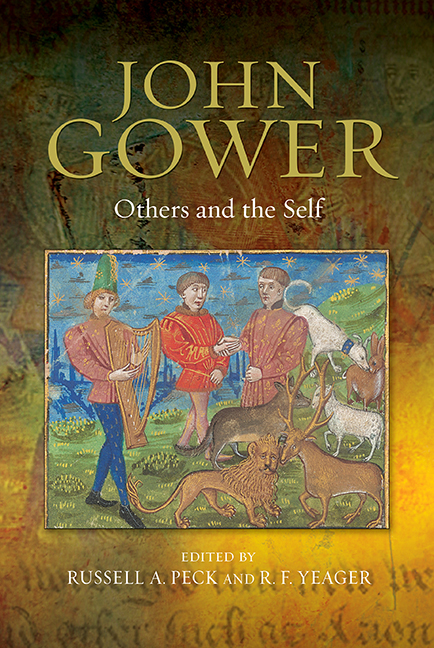Book contents
- Frontmatter
- Contents
- List of Illustrations
- Abbreviations
- Introduction
- PART I KNOWING THE SELF AND OTHERS
- PART II THE ESSENCE OF STRANGERS
- 6 Sensation and the Plain Style in John Gower's Confessio Amantis
- 7 Violence without Warning: Sympathetic Villains and Gower's Crafting of Ovidian Narrative
- 8 Gower, Lydgate, and Incest
- 9 Gower's Jews
- 10 Letters of Old Age: The Advocacy of Peace in the Works of John Gower and Philippe de Mézières
- PART III SOCIAL ETHICS, ETHICAL POETICS
- Bibliography
- Index
- VOLUMES ALREADY PUBLISHED
9 - Gower's Jews
from PART II - THE ESSENCE OF STRANGERS
Published online by Cambridge University Press: 30 April 2019
- Frontmatter
- Contents
- List of Illustrations
- Abbreviations
- Introduction
- PART I KNOWING THE SELF AND OTHERS
- PART II THE ESSENCE OF STRANGERS
- 6 Sensation and the Plain Style in John Gower's Confessio Amantis
- 7 Violence without Warning: Sympathetic Villains and Gower's Crafting of Ovidian Narrative
- 8 Gower, Lydgate, and Incest
- 9 Gower's Jews
- 10 Letters of Old Age: The Advocacy of Peace in the Works of John Gower and Philippe de Mézières
- PART III SOCIAL ETHICS, ETHICAL POETICS
- Bibliography
- Index
- VOLUMES ALREADY PUBLISHED
Summary
Judging from the nearly complete lack of mention in the published record, ascertaining what might have been John Gower's attitudes toward Jews has never provoked much scholarly interest. The contrast with Chaucer on this as on so many points is very striking. Interpretations of the “Prioress's Tale” are thick on the ground, and rich in their disagreement over what such virulent anti-Judaism reveals about the character of Madame Eglentyne, the Canterbury Tales, and about Chaucer himself. In recent years, as the subject of real and imaginary Jews in medieval societies has attracted increased scrutiny, the focus has widened for Chaucer too, to draw in additional narratives of his, notably the “Man of Law's Tale,” where the Jewish “presence” is an absence, but, it has been argued, can be teased out theoretically. In all of this, Gower's name has come up, albeit in the usual fashion: that is, readers of Chaucer (and the more so in the study of fourteenth-century anti-Judaism, medievalists at large) habitually have reached out to hail Gower in passing, whenever a corroborative snippet seems wanting. The silence is particularly puzzling when Chaucer and Gower tell the same tale—e.g., the “Man of Law's” and the “Tale of Constance,” which latter, it has been shown, served Chaucer as a primary source.
Yet viewed from above, such glancing references to Gower's ideas about Jews are perhaps understandable. Gower has much to say about many topics, but very little about Jews qua Jews to draw scholars’ notice. Of the tens of thousands of French, Latin, and Middle English lines Gower wrote, fewer than 300 do so, of which 122 make up the “Tale of the Jew and the Pagan,” in Book VII of the Confessio Amantis. Primarily here I want to look closely at that tale, but it may be efficacious to begin an approach from some distance. To start with, we need to recognize that Gower subscribed to the distinction widely held by most Christians in the Middle Ages between those living prior to the birth of Christ and all who came after. Thus the Judaism of a righteous follower of the Old Law—Abraham, Moses, Daniel, etc.
- Type
- Chapter
- Information
- John Gower: Others and the Self , pp. 183 - 203Publisher: Boydell & BrewerPrint publication year: 2017

